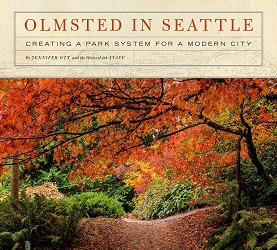
Most people in Seattle know that the name Olmsted is connected to the city’s landscapes. This elegant book presents both the context and the details of that connection. The text is clear and engaging, and the photographs and maps are handsome as well as instructive. For the many landscape designs, the reader may want to keep a magnifying glass at hand to help with details.
Two popular movements help explain how Seattle movers and shakers came to hire and support the plans of the far-off and famous Olmsted Brothers, a Brookline, MA firm. Most significant was the City Beautiful Movement, which spread the idea that any city worth anything needed to be beautiful. The other was the Playground Movement, which encouraged cities to develop many playgrounds, so that even poor children could grow up healthy and “moral.”
Olmsted in Seattle carries the reader chronologically through the planning and execution of plans for many of the city’s parks and boulevards. John C. Olmsted, who visited Seattle and created plans in 1903 and 1908, was the nephew (and stepson) of Frederick Law Olmsted, Sr., of New York’s Central Park fame. Ott shows the progress, the politics involved, and the compromises necessary to carry out the plans. One compromise: In 1909 John Olmsted noted that walkways should have been included parallel to several drives, including Lake Washington, Montlake, and Washington Park. In our current need for more such paths for bikes and pedestrians, we can surely wish those had been built.
“Borrowed landscapes” were a major part of Olmsted’s planning. He designed each park to take advantage of its natural contours, but especially to use views of mountains, water, and other vistas to make the park seem larger than it was. The gorgeous mountain and water views from Fort Lawton, for instance, informed Olmsted’s plea to acquire it as a park, a wish only fulfilled years later with the inclusion of Discovery Park.
Near the end of the book Ott shows how the concepts that Olmsted promoted, such as curved paths, have been adapted in the decades afterward, so that the Olmsted influence continues.
The whole history depicted in
Olmsted in Seattle is worth reading. On the other hand, readers in a hurry can just use the excellent index to trace the history of their favorite parks. Or they can just page through, admiring the photos, informational side bars, and awesome maps.
Editor's note: This is one of many valuable publications not currently available electronically. We look forward to welcoming borrowers when the library reopens.